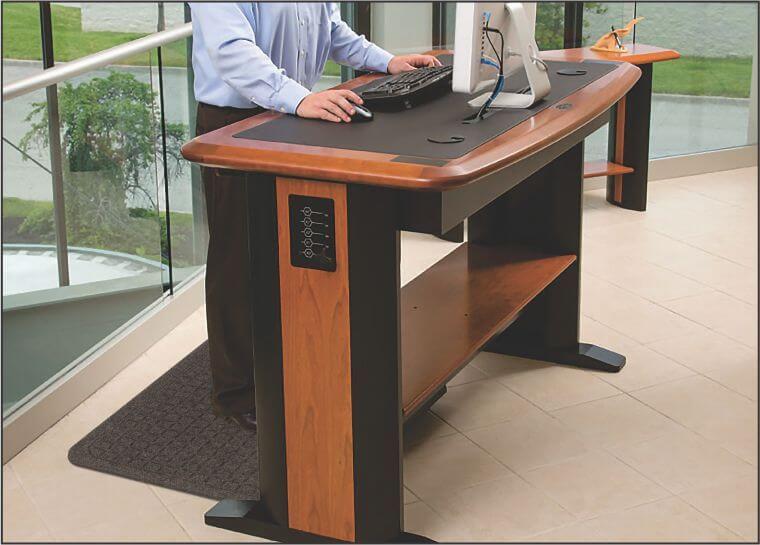
What Do Anti-Fatigue Mats Do?
Anti-fatigue mats are essential tools for reducing discomfort and enhancing productivity in various settings.
Whether you’re standing for long periods in the workplace or at home, understanding the benefits of these mats can significantly impact your well-being and efficiency. This article explores the importance, benefits, and functionality of anti fatigue mats to help you make an informed decision.
In this article, you will learn:
- How anti-fatigue mats improve health and reduce fatigue.
- The science behind how they work to enhance comfort.
- Tips for choosing the best anti fatigue mat for your needs.
Let’s dive into understanding what anti fatigue mats are.
Understanding Anti Fatigue Mats
What Are Anti-Fatigue Mats?
Anti fatigue mats are specially designed floor mats intended to reduce discomfort and fatigue caused by standing for long periods. They are commonly used in environments where individuals are required to stand for significant portions of their day, such as in industrial settings, retail environments, and even home kitchens.
Brief History and Development
The concept of anti-fatigue mats dates back several decades, with early versions primarily used in industrial settings. These mats were initially designed to provide a cushioning effect to alleviate the stress on workers’ legs and backs. Over time, advancements in material science and ergonomics have led to the development of more effective and comfortable mats that cater to a broader range of environments and applications.
Common Materials and Types
Anti fatigue mats are made from various materials, each offering different levels of comfort and durability:
- Rubber: Known for its durability and slip-resistant properties, rubber mats are ideal for industrial and high-traffic areas.
- Foam: Foam mats provide excellent cushioning and are often used in less demanding environments, such as residential kitchens and home offices.
- Gel: Gel-filled mats offer superior comfort by conforming to the contours of the feet, making them suitable for environments where standing for long periods is unavoidable.
Types of anti fatigue mats include:
- Modular Mats: These can be interlocked to cover larger areas.
- Individual Mats: Designed for personal use, such as in front of a workbench or kitchen counter.
- Speciality Mats: Tailored for specific applications, like those with anti-static properties for use in electronic assembly areas.
Benefits of Using Anti-Fatigue Mats
Health Benefits
Anti fatigue mats offer significant health benefits by reducing the physical stress associated with standing for long periods. They help alleviate discomfort in the feet, legs, and lower back, which can lead to a reduction in overall fatigue. This is particularly important in preventing musculoskeletal disorders, which are common among workers who stand for extended durations. By providing a cushioned surface, these mats encourage subtle muscle movements that improve blood flow and reduce stiffness.
Improved Productivity and Worker Satisfaction
In workplace settings, the use of anti fatigue mats can lead to increased productivity and higher levels of worker satisfaction. Employees who are comfortable and less fatigued are likely to be more focused and efficient in their tasks. Reduced discomfort translates to fewer breaks and lower absenteeism, contributing to overall workplace efficiency. Furthermore, when employers invest in ergonomic solutions like anti fatigue mats, it demonstrates a commitment to employee well-being, which can boost morale and job satisfaction.
Enhanced Safety
Anti fatigue mats also enhance safety by reducing the risk of slips and falls. Many of these mats come with non-slip surfaces that provide additional traction, making them particularly useful in environments where spills and wet floors are common, such as kitchens and manufacturing floors. By offering a stable and secure surface, anti fatigue mats help prevent accidents and contribute to a safer working environment.
How Anti Fatigue Mats Work
Explanation of the Science Behind Anti Fatigue Mats
The primary function of anti fatigue mats is to reduce the strain on the body caused by prolonged standing. They achieve this through their unique design and materials, which create a softer and more supportive surface compared to hard floors. This design promotes subtle, frequent muscle movements, also known as micro-movements, which help to increase blood flow and reduce the pooling of blood in the lower extremities.
How They Distribute Weight and Reduce Strain
Anti fatigue mats are engineered to distribute the weight of the body more evenly across the feet, reducing pressure points and minimizing the strain on specific areas like the heels, arches, and balls of the feet. The cushioning effect of the mat absorbs some of the impact from standing and walking, which helps to reduce the stress on joints and muscles. This redistribution of pressure also helps in maintaining a more natural posture, reducing the likelihood of developing musculoskeletal issues.
Impact on Blood Circulation and Muscle Activity
Standing on a hard surface for extended periods can restrict blood flow and cause fatigue due to the lack of movement. Anti fatigue mats encourage subtle shifts in posture and weight distribution, promoting continuous muscle activity. This activity helps to pump blood back to the heart, enhancing circulation and reducing the risk of swelling and varicose veins. By keeping the muscles engaged, these mats prevent the stiffness and discomfort often associated with prolonged standing.
Different Environments for Anti-Fatigue Mats
Industrial and Commercial Use Cases
Anti-fatigue mats are widely used in various industrial and commercial settings where workers are required to stand for extended periods. In factories and assembly lines, these mats help reduce the physical strain on workers, leading to fewer injuries and improved productivity. Retail environments, such as supermarkets and cashier stations, also benefit from anti-fatigue mats, as they help employees stay comfortable and focused during long shifts.
Use in Residential Settings
Anti fatigue mats are not just for workplaces; they are increasingly popular in residential settings as well. In home kitchens, these mats provide relief for individuals who spend a lot of time cooking or washing dishes. Home offices also benefit from anti fatigue mats, especially for those who use standing desks. By reducing fatigue, these mats make household chores and office work more comfortable and less tiring.
Specific Industries That Benefit the Most
Certain industries benefit significantly from the use of anti-fatigue mats due to the nature of their work:
- Healthcare: Medical professionals, such as surgeons and nurses, often stand for long hours. Anti-fatigue mats can help reduce the physical toll on their bodies.
- Retail: Cashiers and stock clerks who spend most of their day on their feet can benefit greatly from the added comfort and reduced fatigue.
- Hospitality: Chefs, bartenders, and servers in the hospitality industry experience less fatigue and discomfort when using anti fatigue mats in their work areas.
Choosing the Right Anti Fatigue Mat
Factors to Consider When Selecting an Anti Fatigue Mat
When choosing an anti fatigue mat, several factors should be considered to ensure you select the best option for your needs:
- Material: The material of the mat affects its durability and comfort. Rubber mats are durable and suitable for industrial environments, while foam mats provide excellent cushioning for residential use.
- Thickness: Thicker mats generally offer more cushioning, but they need to balance comfort with stability. A mat that is too thick might cause instability, whereas a too-thin mat might not provide enough support.
- Size: Consider the size of the area where the mat will be used. Mats come in various dimensions, from small personal mats to larger mats that cover extensive work areas.
- Surface Texture: The texture should provide adequate grip to prevent slipping. Mats with beveled edges can reduce the risk of tripping.
- Ease of Cleaning: Depending on the environment, you may need a mat that is easy to clean and resistant to spills and stains.
Conclusion
Anti-fatigue mats are crucial in reducing discomfort and enhancing productivity for individuals who stand for long periods. Understanding their benefits, functionality, and appropriate selection criteria is essential for maximizing their effectiveness.
In this article, you have learned:
- How anti-fatigue mats improve health and reduce fatigue.
- The science behind how they work to enhance comfort.
- Tips for choosing the best anti-fatigue mat for your needs.
By incorporating anti-fatigue mats into your workspace or home, you can significantly improve your comfort, reduce health risks, and enhance overall productivity. As the next step in optimizing your standing comfort, consider exploring ergonomic accessories and practices that complement the use of anti-fatigue mats for a holistic approach to workplace and home ergonomics.
